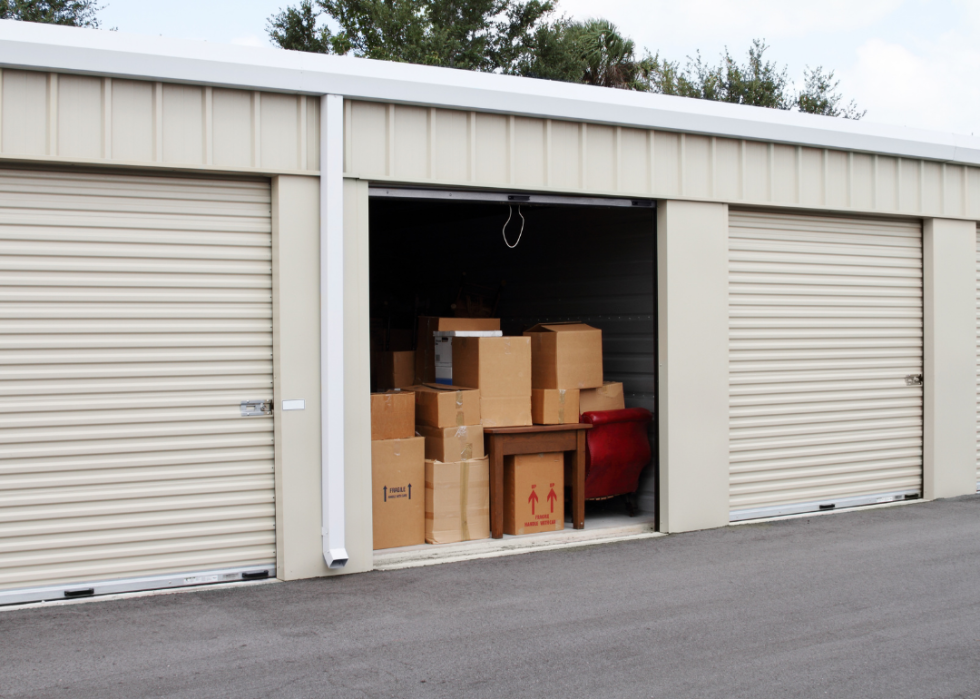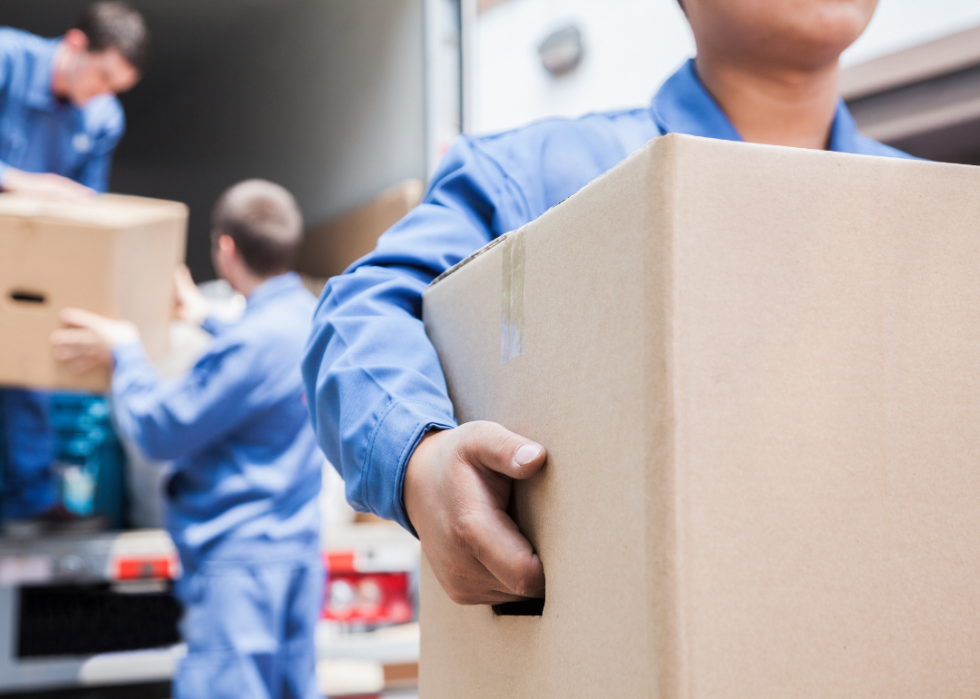
This story originally appeared on Extra Space and was produced and distributed in partnership with Stacker Studio.
5 unexpected costs of moving
While contemplating the financial outlay of a move, a lot of people limit their projections to the cost of professional movers, a pile of boxes, and plenty of packing tape.
But most moves require a pile of additional expenses that can quickly throw off a budget if they're not accounted for. Extra Space Storage compiled a list of five often-overlooked moving costs to help people properly budget and plan.
The expense of moving can vary greatly based on various factors including whether the move is local or long-distance, and what types of items are being transported. For example, appliances and large furniture add weight and space to the mix and can increase moving costs significantly. A base quote for a local move can range from $500 to $2,000, but this may not include fuel or drive-time. For those making long-distance moves, initial over-the-phone quotes typically start around $7,500.
The U.S. Census Bureau reported that fewer people moved in 2021 than in any year since the bureau began tracking this data in 1948, and trends indicate those who did, moved from the city to the suburbs. This trend creates several particular challenges, among them navigating large moving vehicles through dense urban areas, negotiating apartment or condominium units that may lack service elevators or have narrow stairwell access, and the potential for askew timelines by which the date one moves out may not coincide with the date their new home is ready for them.

Renting a storage unit
There are many reasons a storage space becomes necessary to rent during a move, from the new home not being quite move-in ready to a downsize that can’t accommodate every possession.
Storage in transit is a service offered by moving companies for those moves where a household’s contents will need to be held until a new residence is ready for move-in. The average rate for this service is 40 cents per cubic foot for 30 days. A definite perk is having the same moving company handle your items from pickup all the way to delivery, but there are some considerations to bear in mind.
When researching spaces, consider your needs. What is security like on the premises? Do stored items require climate control? Will you need to access the space/stored items? If the space is on the upper floor, is there an elevator? Is there lighting in the unit? Can a moving truck fit into the space needed to load/offload?
When finding a storage space on your own, learn what’s required of tenants at your chosen location. In most cases, some form of insurance that covers one’s belongings will be necessary. It’s likely, too, that supplying the lock to be used will be the renter’s responsibility.
Take time to review the rental agreement. Rates can vary based on the size of the unit and options chosen, such as climate control. Make sure that you understand the cost of monthly rates and fees after the initial move-in. Get clarity, as well, on what is required when ending a contract in terms of the notice.

Packing supplies
How many packing boxes and how much tape to buy is tough to gauge; consequently, it’s one area where costs can run up quickly. But there are myriad options when looking to cut costs on these packing supplies. You can score free boxes thanks to social media platforms like Nextdoor and Facebook or look for notices of people giving them away, and if you don’t see any, put out a request.
Another option is grabbing boxes from stores that will toss them out anyway. It might sound awkward to approach a retail or grocery store manager in this way, but many are accommodating. Stores often break boxes down prior to disposal, so arrange with the store manager to be there beforehand to score on free packing boxes.
Nevertheless, most movers ought to plan on purchasing cardboard boxes at some point. Specialty boxes, such as those for paintings or wardrobe items that can’t be folded, can be very pricey. Purchasing tools ahead of time is often cheaper than from a moving company. Packing up a three-bedroom, two-bathroom house can run up to $200 in box costs. If you opt for plastic bins, remember many movers require these to be taped around the lid and body so they don’t come apart during a move. This can increase tape supply costs and, should you forget to do this on move day, cause delays.
One eco-friendly, cost-saving alternative to purchasing bubble wrap or foam wrapping is to pack delicate or breakable items with towels, sheets, blankets, and even thick items of clothing. Ask your moving company in advance if they handle larger breakable items, such as glass tabletops. If so, they will usually have protective blankets for such items; if they do not, you’ll have to see to this yourself.

Losing your security deposit
The U.S. Department of Housing and Urban Development houses a complete list of tenant’s rights for each state. All renters should educate themselves as to the particular rights and statutes in their state. Your state may require a landlord to return a deposit within a specified time. It is also crucial to read the rental or lease agreement requirements for the return of the security deposit, as there are likely requirements for the renter as well.
Most agreements obligate the renter to give a specific period of notice: typically 30, but up to 120 days. There are also terms of the condition by which the renter must turn over the unit to the landlord. Plan a walk-through with your landlord to go over any property damage or repairs. When going through this process, be aware of your rights when it comes to normal wear and tear that’s not deductible from a security deposit. Provided you meet your requirements as a renter, you may have the right to legal recourse if your landlord withholds your security deposit.
Some states also require landlords to pay interest earned on a security deposit over the course of a tenancy, so check to see if your state falls into this category.

Gas and other associated travel costs
When vetting moving companies, it’s important to learn how each mover factors fuel into quotes. With gas prices continuing to rise, many moving companies have resorted to passing additional fuel expenses on to their customers.
As to the cost of fuel required for moving your own vehicles, it's important to calculate how many vehicles need to be transported, particularly those you may not be able to drive yourself such as second cars, boats, or campers.
You may have to hire someone to transport your vehicle, in which case there are options to ship a car. If you have a leased vehicle, this may be a crucial decision, as mileage overages can catch up with you once your lease ends. When researching car-shipment options, check to see if your car insurance covers your car in transit, or whether the shipper offers insurance if it does not. Photograph your vehicle before it’s loaded and check for damage upon delivery.
Transporting pets is another cost to keep in mind for local and long-distance moves. There may be a need to board pets for a period of time, or to find accommodations that allow pets for an additional fee. In the event that you are flying to your new home, check various airlines’ pet and animal policies before booking. Many airlines have adjusted their approach to smaller pets and those considered service animals.

Tipping movers
Tipping may not be required for movers, but it’s a common and widely accepted practice. A good rule of thumb is to tip each mover at least $10 for a half-day and $20 for a full day.
Tipping each member of the crew is often common, though another option is to give the tip money to the crew boss for distribution. While some moving companies will allow for tacking tips onto the main bill, others won’t. Regardless, have cash on hand. It will simplify the process and assure that you are able to thank your crewman face to face.
One final tip: Make sure there is plenty of bottled water and other hydrating drinks on hand during the move.



